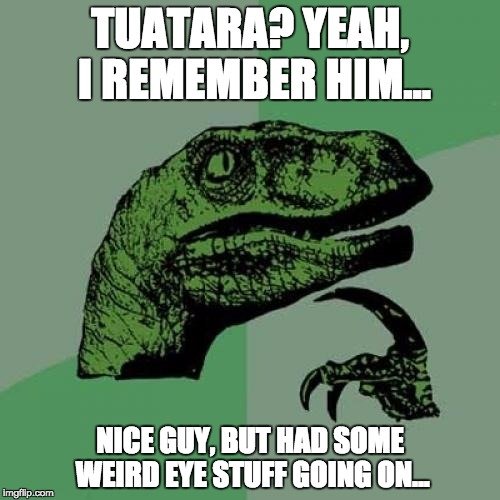What Animal Has The Largest Pineal Gland
The terminal time you constitute yourself in an intense conversation with a very "spiritual" person at a bar,discussing chakras, energy and different planes of existence, there's a good gamble they may have mentioned their "third eye". In well-nigh cases, the thought of a 3rd heart is symbolic, but it does heighten the question… are at that place whatsoever animals that really possess a third middle?
Brusque Answer: Yes, but it is more than unremarkably called a parietal middle, and is only establish in certain species of lizards, sharks, bony fish, salamanders and frogs. It typically doesn't encounter, simply is instead photoreceptive in nature.
Recommended Video for you:
The History of the Third Eye
While the idea of humans having a third eye seems crazy – and impossible – if we go far plenty back in our evolutionary history, there was a point where it could have really happened. When our fish-like predecessors were developing, this trait was a dividing bespeak – a co-operative in the dandy evolutionary tree – and we left information technology behind. Had mammals and all other vertebrates not gone the way of symmetry, we could have benefitted from being able to look at the earth to a higher place usa. Some animals still get to relish a "third" eye, but information technology doesn't have quite the aforementioned part as the other eyes that nosotros have all come to appreciate and recognize.
In fact, homo beings still have the evolutionary remnant of that third eye, but it is buried deep in the encephalon, and is known as the pineal gland. It is very important for hormone regulation in mammals and vertebrates. For other animal species, far removed from man beings, the pineal gland is just ane half of the epithalamus. At a sure point in evolutionary history, having a sensitive point on elevation of the caput was selected in some creatures, but not in others. The subsequent structure, known as the epithalamus, is composed of the epiphysis (the pineal gland in humans, or pineal organ in other species) and the parietal organ (the "tertiary middle").

When we look back through the fossil tape, some of the oldest vertebrates exercise announced to take a socket on the top of their head where a third eye could accept ostensibly been located; this socket tin notwithstanding be seen in the bone construction of certain amphibians and reptiles, just it disappeared long ago in birds and other mammals.
While this two-part organ is not found in any mammals, it is quite common in diverse species of lizards, frogs, bony fish, sharks and salamanders. Nonetheless, it does not function in the same way as the main optics that provide animals with the power of sight. The parietal centre is essentially just a spot on their head that is receptive to light, which ways that it is somewhat sensitive to motion and the changes in calorie-free that occur when something moves through an surroundings. Fifty-fifty for those few species and animal types that possess this "third middle", it is typically covered by a layer of skin, is difficult to spot with the naked eye, and is much smaller than the forepart-facing eyes.
Will All Animals Eventually Lose This Third Eye?
It is hard to predict the management that evolutionary history will go, and there are always some species that seem to slip through the cracks of fourth dimension, maintaining erstwhile adaptations for hundreds of millions of years longer than their long-extinct cousins. When it comes to the pineal eye, for example, the animal with the virtually pronounced "3rd eye" is really the tuatara, an ancient lizard owned to New Zealand. This lizard is a remnant from theRhynchocephalia lodge, which flourished roughly 200 million years ago, merely is at present completely extinct, except for this one type of cadger.

The tuatara has a well developed parietal eye, which actually has a lens and a retina. Information technology is most clearly visible in young tuatara, before a thin layer of skin grows over the peak, only it is able to detect light very well, and helps this lizard-like reptile make up one's mind seasonal and temporal changes. In the case of the tuatara, the eye still serves its original function, and there is no clear reason why information technology would always disappear. Once again, natural pick is a highly unpredictable force.
In other animals, such equally lampreys, some of the nigh primitive creatures still present on Earth, two parietal eyes are present, one from the parietal gland and the other from the pineal gland. These 2 eyes are lined up on pinnacle of the head, like to where the single parietal eye is now located in invertebrate and reptile species. Due to lampreys ancient status, some researchers believe this was the original orientation for all "third optics", which gradually shifted to having only i, and so eventually to none.
The number of eyes in animals is not stock-still, nor is in that location a right or wrong number for an animal to have. Arachnids, for example, have 8 eyes, with pairs that serve different purposes (e.g., some for detail, some to perceive motion, etc.). Praying mantises have 5 eyes, as do many other insects, with two big compound eyes complemented past three smaller eyes that find lite, similar to the parietal eye discussed to a higher place.
Finally, some animals on the sea floor – where evolutionary adaptation gets truly foreign – have even more bizarre visual arrangements. Starfish accept eyes at the end of every arm, giving them a broad field of 360-degree vision, while some bivalves, such as clams, can take thousands of photoreceptor optics on the surface of their mantle. Some scallops can besides accept more that 100 sophisticated reflector eyes, resembling a spherical concave mirror, that actually allow them to "see" – and even swim!
Conspicuously, eyes come in all shapes, sizes, configurations and functions, and that isn't likely to change anytime shortly. The side by side time someone cracks a joke virtually their third eye existence blind, you tin can explicate that they still accept the bones structure of a tertiary heart (pineal gland), only it sunk further down into the brain to serve a dissimilar, more important purpose!
Suggested Reading
-
Fuzz: When Nature Breaks the Law -
Zoology: The Secret Earth of Animals -
A World on the Wing: The Global Odyssey of Migratory Birds
Was this commodity helpful?
Yes No
Help the states brand this article meliorate
Source: https://www.scienceabc.com/nature/animals/can-animals-have-a-third-eye.html
Posted by: rossarman1993.blogspot.com




0 Response to "What Animal Has The Largest Pineal Gland"
Post a Comment